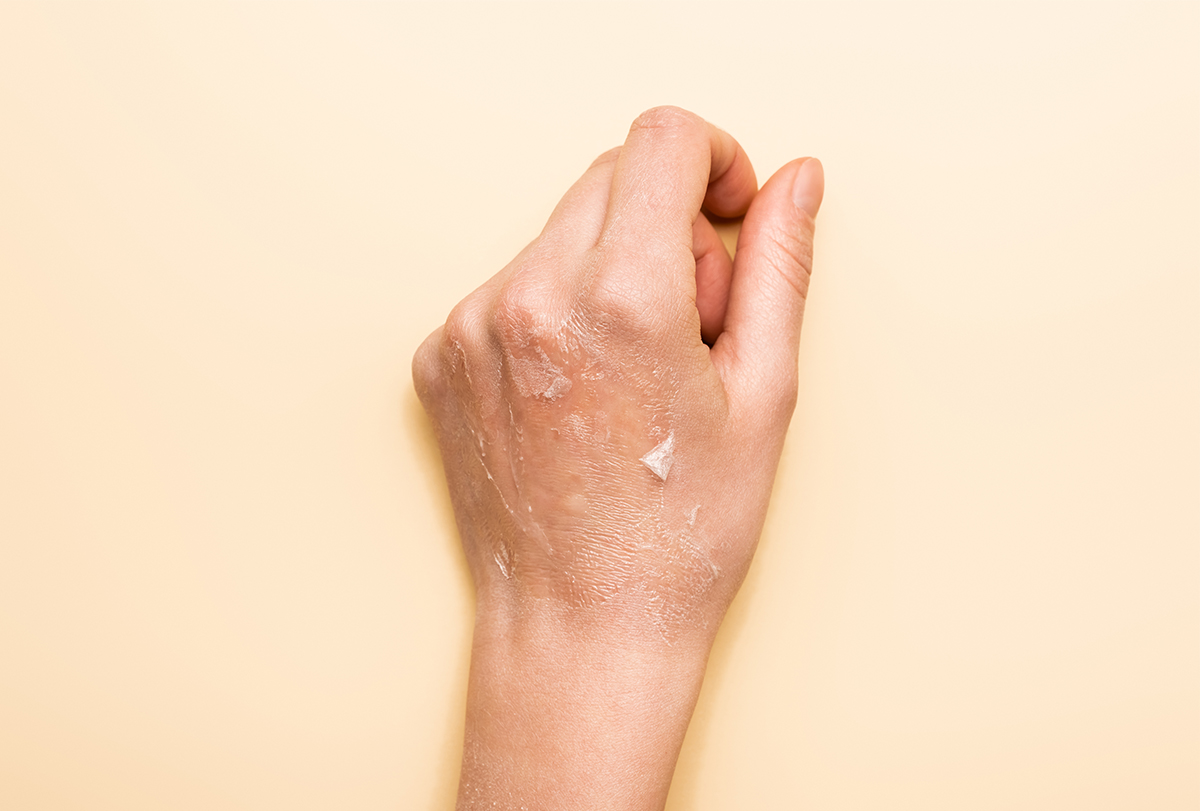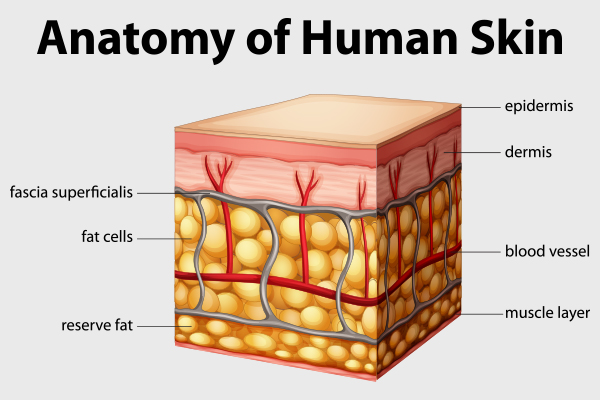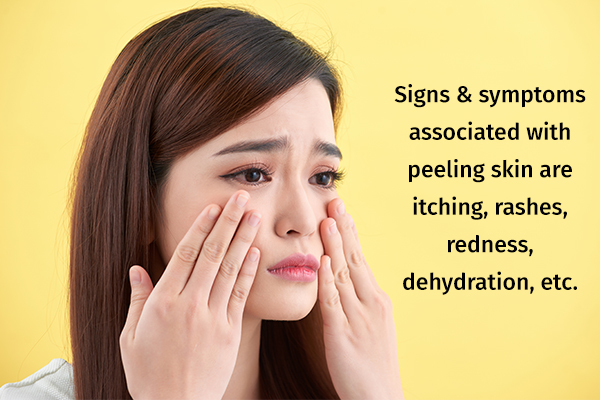In this article:
The skin sheds dead cells from its surface every hour of every day, which then become part of the dust you see in the environment. These discarded cells are replaced by new ones that rise to the top from the deeper skin layers.

It takes 2–4 weeks for the entire superficial layer of the skin to be regenerated this way, but the process is barely noticeable since the sloughed-off cells are too minuscule to be observed.
But a number of factors can accelerate this cycle such that you start shedding excessive skin cells at once. This will manifest in the form of skin flaking and peeling, which are quite noticeable and irritating.
Common triggers for skin peeling include medications, weather, dehydration, underlying illnesses, and cosmetic products, among many others. This article will shed light on some of the major culprits behind skin peeling, common treatment modalities to address it, and complications associated with it.
Skin Regeneration Process
To understand the skin regeneration process, you must first understand the structure of the skin. It is basically composed of three layers:
- Epidermis – the outermost layer
- Dermis – the middle layer
- Hypodermis – the deepest layer of subcutaneous fat

The epidermis is further divided into the following five layers from the most exterior to the innermost:
- Stratum corneum
- Stratum lucidum
- Stratum granulosum
- Stratum spinosum
- Stratum basale
The worn-out epithelial or skin cells are concentrated in the stratum corneum, but they do not originate there.
The deepest layer of the epidermis, called the stratum basale, produces living epithelial cells that travel upward to the stratum granulosum, where they become keratinized. This means that their nucleus is replaced by a skin protein called keratin.
Keratinized cells have a dead, hard, and impervious surface that allows them to form a strong barrier between the outside world and the internal organs. The skin, hair, and nails are all made of keratinized cells. These cells migrate to the outermost layer and are gradually sloughed off into the environment.
Causes of Peeling Skin
Skin peeling can be the result of one or more of the following factors:
- Staying in the sun for too long without wearing protective clothing or sunscreen will allow the UV rays to do considerable damage to your skin cells right to their very DNA. This makes your skin age faster (photoaging) and makes you more prone to skin peeling. (1) In fact, unprotected sun exposure during peak hours (10 a.m. to 4 p.m.) can burn your skin, which will then peel away.
- Excessive exposure to dry winds can dehydrate your skin and induce or aggravate skin peeling.
- Naturally dry skin often has a problem of skin peeling.
- Allergies that trigger allergic contact dermatitis can cause your skin to become dry and flaky and eventually peel.
- This problem can stem from underlying medical conditions (such as hypothyroidism), disorders affecting the skin (such as eczema, psoriasis, (2) exfoliative keratolysis, and ichthyosis), skin infections (such as ringworm, athlete’s foot, and cellulitis), dermatitis (such as seborrheic dermatitis), some types of cancers, and rare genetic skin disorders (such as peeling skin syndrome). (3)
- Medications for blood pressure or seizure, penicillin, chemotherapy, and other drugs can also induce skin dryness and peeling as a side effect.
- Skin peeling can also be a sign of a weakened immune system.
- Nutritional deficiencies (4) such as niacin deficiency can make your skin dry and flaky.
- Using cosmetics or skin products that contain harsh chemicals, such as parabens (fragrant-producing agents), isopropyl/propyl/propanol/ethanol alcohol, formaldehydes, and sulfates, can irritate and dry out your skin over time.
- Some cosmetic procedures have an after-effect that may leave your skin dry.
- Exposing your skin to water with a high concentration of mineral ions such as chlorides and fluorides can cause dry and peeling skin, which is especially a problem for swimmers.
- Frequent or excessive bathing, especially with hot water, can also strip the natural moisture from your skin and make it flaky.
Signs and Symptoms Associated With Peeling Skin

Peeling skin is characteristically dry and flaky and is often accompanied by the following symptoms:
- Itchiness or pruritus
- Rashes
- Redness (erythema)
- Dehydration
- Scaling of the skin
- Skin fissures or cracking
- Skin tightness after bathing
- Skin inflammation
- Extreme sensitivity to external irritants such as heat, sweat, or water
Medical Treatment for Peeling Skin
The treatment for peeling skin aims to address its underlying cause. Thus, you need to get a proper diagnosis first before the doctor can prescribe the appropriate medication or therapy.
Here are some of the commonly used interventions to control, repair, and soothe peeling skin:
- The doctor may prescribe topical retinoids and steroids to treat peeling skin caused by psoriasis (5)
- Exfoliative keratolysis, which causes the skin of the fingers, palms, and soles to peel, is usually treated with ointments that contain lactic acid, silicone or urea, acitretin, and photochemotherapy.
- Antihistamines, antimicrobials, calcineurin inhibitors, (6) and corticosteroids are often used to treat skin peeling brought on by dermatitis. (7)
- Peeling of facial skin caused by UV exposure is usually treated with medications such as corticosteroids and doxycycline as well as clinical procedures such as chemical peels using glycolic acid. (8)
Diagnosing the Cause of Peeling Skin

Diagnosing the exact cause behind skin peeling entails the following steps:
- Physical examination of your skin
- Assessment of your medical and family history
- Inquiry about your skin care regimen and the cosmetic products you use
- Tests that may include a skin biopsy, skin scrapings tests to detect fungal infections, and patch tests to rule out potential contact allergies
Risk Factors for Peeling Skin
The following factors can predispose you to peeling skin:
- Atopy, which means you are genetically predisposed to allergic diseases such as atopic dermatitis (eczema) that often cause skin peeling
- Dry and cold weather, when there is no moisture in the air to keep your skin hydrated
- Excessive use of indoor heating, which can suck the humidity out of your living environment
- Natural aging process, wherein your skin gets progressively thinner and drier due to a decline in the production of collagen and skin lipids
- Inadequate or irregular skin care routine, especially if you don’t moisturize your skin daily
- Occupations that require you to wash your hands frequently or immerse your skin in water for too long (nurses, aestheticians, and industrial workers)
- Frequently washing your skin, which can strip away its inherent lipids, especially if you use hot water
- Taking frequent and prolonged baths or showers, which can dehydrate your skin
- Outdoor jobs or activities that subject your skin to the harmful UV rays of the sun on a regular basis, such as farming, construction work, and sports or athletics
- Sucking your finger frequently, which can cause the skin of the fingers to peel
- Licking your lips frequently, which can cause chapped lips
Complications of Excessive Peeling

If skin peeling is left untreated or poorly managed, it can lead to the following complications:
- Secondary skin infections
- Painful blisters
- Discoloration
- Fever
- Nausea and vomiting
- Photoaging
When to See a Doctor
Peeling skin requires medical attention if the condition does not resolve despite proper skin care and home treatment, if the skin becomes too dry, painful, and discomforting, or if skin peeling is accompanied by the following symptoms:
- Chills
- Bleeding of the skin
- Oozing of pus from the skin
Final Word
Your skin sheds dead cells every day to make way for new ones, but you don’t necessarily notice it. This regeneration process is crucial for maintaining healthy skin, but certain factors can speed it up to the extent that your skin starts to peel.
This can be due to environmental or lifestyle factors that can be easily managed by avoiding irritants, following a stringent skin care routine, exercising proper self-care, eating healthy, and using OTC lotions or ointments.
But if the condition persists or worsens despite home treatment, you should see a skin specialist to figure out the underlying cause. In many cases, peeling skin is symptomatic of inflammatory skin disorders that require proper medical treatment.

- Was this article helpful?
- YES, THANKS!NOT REALLY


